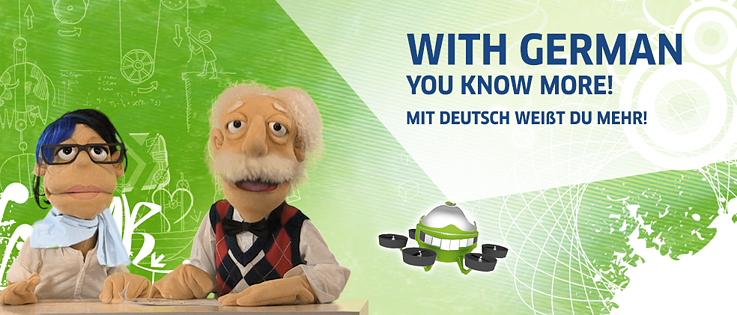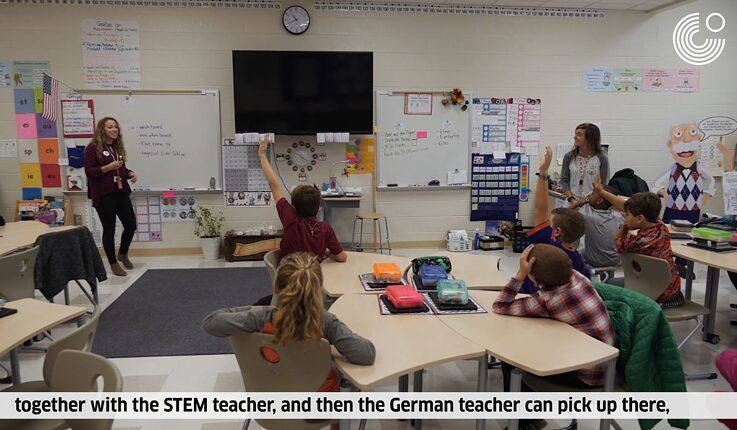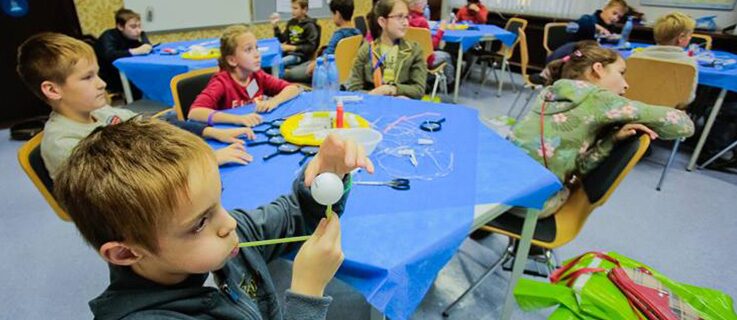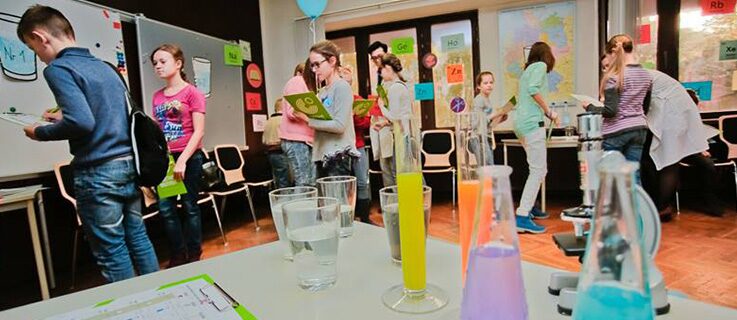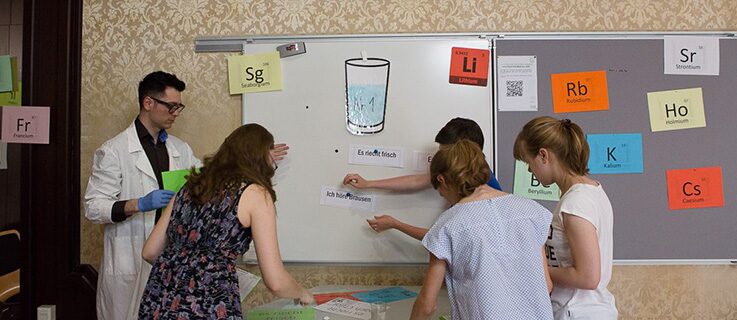In Schools
The Kinderuni in School - german and stem classes
The Kinderuni can be used for learning in school in different contexts and areas of application. Individual lectures can be incorporated into classroom instruction based on the theme being taught or outside of the classroom according to students’ interests or in connection with other subjects.
THEME-ORIENTED GERMAN-AS-A-FOREIGN-LANGUAGE INSTRUCTION
The individual lectures of the Kinderuni provide building blocks for teaching German-as-a-foreign-language. The goal here is language acquisition through theme-oriented instruction in German. German instructors (together with teachers of other subjects, if desired) can integrate the theme of the lecture into their instruction, and can thereby expand and deepen it.
FOR CLIL TEACHING AND PROJECTS EXTENDING ACROSS SUBJECTS
The goal of CLIL is to acquire knowledge in specific subject areas with the help of language. The Kinderuni lectures can be integrated into CLIL instruction as supplemental material. German language lessons can be used as language preparation for CLIL lessons.
INSIDE AND OUTSIDE OF CLASS
Didactic materials with guidelines and worksheets are available for teachers who would like to integrate the Kinderuni in the classroom and/or outside of class as an extracurricular activity. The materials can be used in multidisciplinary projects and are available in German and English so that German teachers can work together with teachers of other subjects.
MOTIVATING STUDENTS TO LEARN GERMAN
Our 10-week introduction program 'Learn German through STEM' has been designed for K-8 schools with or without a German program. It can be implemented as an introduction program or as an extra-curricular after-school program. The aim is to instill enthusiasm for foreign language learning ― and for the German language in particular ― into the children and to teach them some very basic German while exploring fascinating STEM-related topics.
The materials from 'Learn German through STEM' can be implemented in regular German classes at K-8 schools and are especially suited as introduction programs and "taster courses" for students who have not yet taken German classes.
In specific cases, the program can also be used in an extracurricular format as a free after-school-program. Here, the Goethe-Institut puts schools in touch with trained Kinderuni experts who conduct the after-school-program free of charge for the school. If you are interested in this, please contact your regional Goethe-Institut.
Materials (free to download):
Lesson 1: Muschelsound (Shell Sound)
Lesson 2: Beatboxing
Lesson 3: Blindenschrift (Braille Alphabet)
Lesson 4: Graffiti
Lesson 6: Schattenspiele (Shadow Games)
Lesson 7: Ameisensturz (Falling Ants)
Lesson 8: Spinnennetz (Spider Web)
Lesson 9: Autopilot
Lesson 10: 3D Druck (3D Printing)
There are three main arguments for this; first, the empirical-experimental method in many subjects, in particular in the sciences, which is also of great value in acquiring a foreign language and leads to similar learning processes; second, learning another language in an authentic context with content that is immediately applicable; and third, the opportunity to associate the spoken language with concrete and definable examples and processes.
CLIL does not just improve students’ success in learning a foreign language, it develops, generally speaking, learners’ ability to communicate and carry out discussions. This is an important prerequisite for success in the world of work or in a course of study.
Introducing CLIL instruction does not require a new curriculum at first. Small project modules in a certain subject area are a good entry point.
The 10 principles of CLIL emphasize this.
- Bilingual subject matter instruction represents a new school subject, because elements (which are already present) are combined and thereby form a new way of transmitting and acquiring knowledge and skills.
- Bilingual subject matter instruction, due to its complex requirements, is a prime example of the new methodical-didactic approaches in education, such as action-oriented and learner-centered learning, as well as learner autonomy.
- In bilingual subject matter instruction, subject-oriented learning takes place in the language and using the language as one organic whole. Thus, a cycle of “language learning, observation, testing, application, generation, and awareness-building” occurs, which takes place repeatedly on both a small and a large scale.
- Conventional foreign-language instruction leads in general to everyday communication abilities (basic interpersonal communication skills, or BICS), whereas bilingual subject-oriented instruction leads to the ability to express complex thought processes (cognitive academic language proficiency, or CALP). In addition, students develop discursive skills pertaining to specific content material. Bilingual learning therefore leads to key competencies.
- Two different sets of learning objectives are not needed for subjects taught bilingually. The subject matter instruction is given primary importance and in turn drives the learning objectives.
- The hard sciences, math, computer science, and technology are particularly suitable for bilingual instruction, for one because both the subject matter and the language are inherently empirical-experimental and thus lead to analogous learning methods; secondly, the other language is acquired in an authentic context with immediately applicable content; and thirdly, language work can be associated to a high degree with concrete and describable objects and processes.
- Bilingual subject matter instruction requires cooperative work. It is therefore well designed for project work.
- Bilingual learning is not limited to formally institutionalized forms; it can also be encouraged outside the classroom, i.e. in projects across subject areas.
- Bilingual learning can “take place” in a variety of levels of development, ranging from small, theme-based, multi-week project modules in one subject, to learning-objective-focused half-year or year-long theme cycles of a more comprehensive nature, to incorporation into curricula, and further still the permanent integration into education over the course of multiple years.
- Bilingual learning can begin as early as kindergarten and preschool (in playful ways, of course), can continue in primary school, and then, taking advantage of the full development potential offered by secondary education, extend into its fully developed form.
You can sign up with a teacher account on the platform. This account will grant you the ability to track your students' progress. In your account you will have access to learning scenarios for interactive German lessons with instructions and worksheets that can be downloaded for free. Didactic materials for each lecture can be found in the category For Teachers of the left side menu (please note: you must be logged into your account for the link to work).
DIDACTIC MATERIALS


